List of oldest buildings in Scotland

This article lists the oldest extant freestanding buildings in Scotland. In order to qualify for the list a structure must:
- be a recognisable building (defined as any human-made structure used or intended for supporting or sheltering any use or continuous occupancy);
- incorporate features of building work from the claimed date to at least 1.5 metres (4.9 ft) in height and/or be a listed building.
This consciously excludes ruins of limited height, roads and statues. Bridges may be included if they otherwise fulfill the above criteria. Dates for many of the oldest structures have been arrived at by radiocarbon dating and should be considered approximate.
The main chronological list includes buildings that date from no later than 1199 AD. Although the oldest building on the list is the Neolithic farmhouse at Knap of Howar, the earliest period is dominated by chambered cairns, numerous examples of which can be found from the 4th millennium BC through to the early Bronze Age.
Estimates of the number of broch sites throughout the country, which date from the Iron Age, range from just over 100 to over 500.[2] However, only a small percentage are sufficiently well preserved for them to be included here and some of those that could be remain undated.
As there are relatively few structures from the latter half of the first millennium AD and a significant number from the 12th century, the latter group is placed in a sub-list. There are larger numbers of extant qualifying structures from 1200 onwards and separate lists for 13th-century castles and religious buildings are provided. As the oldest buildings in many of the council areas in the more urbanised Central Belt date from after the 14th century a separate list showing oldest buildings by council area is provided.
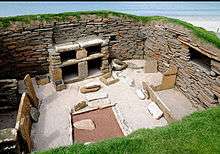
There is also a supplementary list of qualifying structures for which no confirmed date of construction is available and a short listing of substantial prehistoric structures that are not buildings as defined above.
Main list
Neolithic and Bronze Age
| Building | Image | Location | Council area | First built | Use | Notes |
|---|---|---|---|---|---|---|
| Knap of Howar |  |
Papa Westray | Orkney | 3700 BC | House | Oldest preserved stone house in north west Europe.[3][4][5] |
| Midhowe Chambered Cairn | 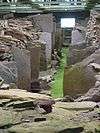 |
Rousay | Orkney | 3500 BC | Tomb | A well-preserved example of the Orkney-Cromarty type on the island of Rousay.[6] |
| Unstan Chambered Cairn |  |
Stenness | Orkney | 3450 BC | Tomb | Excavated in 1884, when grave goods were found, giving their name to Unstan ware.[7][8][9] |
| Knowe of Yarso chambered cairn |  |
Rousay | Orkney | 3350 BC | Tomb | One of several Rousay tombs. It contained numerous deer skeletons when excavated in the 1930s.[7][10][11] |
| Quanterness chambered cairn |  |
St Ola | Orkney | 3250 BC | Tomb | The remains of 157 individuals were found inside when excavated in the 1970s.[7][12] |
| Skara Brae |  |
Sandwick | Orkney | 3180 BC | Settlement | Northern Europe's best preserved Neolithic village.[13] |
| Tomb of the Eagles |  |
South Ronaldsay | Orkney | 3150 BC | Tomb | In use for 800 years or more. Numerous bird bones were found here, predominantly white-tailed sea eagle.[14][15] |
| Grey Cairns of Camster | Upper Camster | Highland | 3000 BC or older | Tomb | A group of three cairns.[16][17] | |
| Taversoe Tuick chambered cairn |  |
Rousay | Orkney | 3000 BC | Tomb | Unusually, there is an upper and lower chamber.[18] |
| Holm of Papa chambered cairn |  |
Holm of Papa | Orkney | 3000 BC | Tomb | The central chamber is over 20 metres long.[19][20] |
| Barpa Langass |  |
North Uist | Na h-Eileanan Siar | 3000 BC | Tomb | The best preserved chambered cairn in the Hebrides.[21][22] |
| Cuween Hill Chambered Cairn | 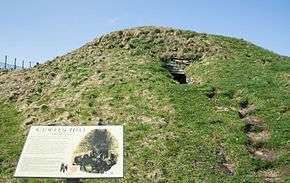 |
Finstown | Orkney | 3000 BC | Tomb | Excavated in 1901, when it was found to contain the bones of men, dogs and oxen.[23][24] |
| Quoyness cairn | 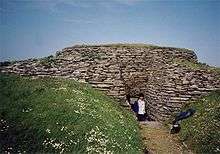 |
Sanday | Orkney | 2900 BC | Tomb | An arc of Bronze Age mounds surrounds this cairn.[25] |
| Maeshowe | 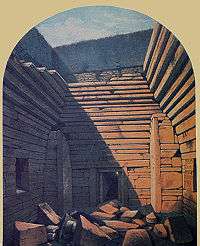 |
Stenness | Orkney | 2800 BC | Tomb | The entrance passage is 36 feet (11 m) long and leads to the central chamber measuring about 15 feet (4.6 m) on each side.[26][27] |
| Crantit cairn | Kirkwall | Orkney | 2130 BC | Tomb | Discovered in 1998 near Kirkwall.[28][29] | |
| Rubha an Dùnain passage grave |  |
Skye | Highland | 2000 BC or older | Tomb | On a now uninhabited peninsula to the south of the Cuillin hills.[30][31][32] |
| Corrimony chambered cairn | Drumnadrochit | Highland | 2000 BC or older | Tomb | A Clava-type passage grave surrounded by a circle of 11 standing stones.[33][34] | |
| Balnuaran of Clava |  |
Nairn | Highland | 2000 BC | Tomb | The largest of three is the north-east cairn, which was partially reconstructed in the 19th century. The central cairn may have been used as a funeral pyre.[32][35][36] |
| Vinquoy cairn | 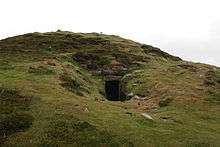 |
Eday | Orkney | 2000 BC | Tomb | At an elevated location on the north end of the island.[37] |
| Glebe cairn |  |
Kilmartin Glen | Argyll and Bute | 1700 BC | Tomb | An early Bronze Age structure with two stone cists.[38][39] |
Iron Age
| Building | Image | Location | Council area | First built | Use | Notes |
|---|---|---|---|---|---|---|
| Dun Ringill |  |
Strathaird, Skye | Highland | 1st millennium BC | Semi-broch | Known to have been occupied in the medieval period by Clan Mackinnon the ground floor living space is only 47 m2.[40][41] |
| Old Scatness |  |
Sumburgh | Shetland | 400-200 BC | Broch and wheelhouse | Like Jarlshof the site was occupied by Iron Age peoples, Picts, and Vikings.[42] |
| Dun Troddan |  |
Glenelg | Highland | 4th century BC to 1st century AD | Broch | One of the best-preserved brochs, the dry-stone walls surviving to over 7 m in height in places.[43][44] |
| Dun Telve |  |
Glenelg | Highland | 4th century BC to 1st century AD | Broch | The best preserved mainland broch, with walls surviving to 10 m, located only 500 metres from Dun Troddan.[43][44] |
| Jarlshof | .jpg) |
Sumburgh | Shetland | 200 BC | Various | A complex of preserved wheelhouses, amongst the remains of a variety of much older and more recent buildings.[45][46] |
| Yarrows broch |  |
Wick | Highland | 200 BC | Broch | Situated on the edge of a loch, underwater stonework may indicate a docking area.[47][48] |
| Dun Vulan |  |
Bornais | Na h-Eileanan Siar | 150 BC | Broch | Originally 10 metres (33 ft) in height, now reduced to walls of 1.52 metres (5.0 ft). A Pictish house was later built within the walls.[49][50] |
| Dun Ardtreck | 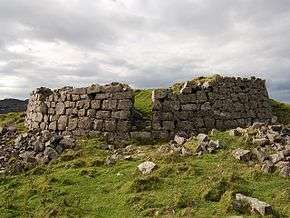 |
Minginish, Skye | Highland | 115 BC | Semi-broch | Initial occupation appears to have been brief and to have "ended in violence and destruction".[51] [Note 1] |
| Broch of Mousa |  |
Mousa | Shetland | 100 BC | Broch | Amongst the best-preserved prehistoric buildings in Europe.[52][53] |
| Ness of Burgi fort | 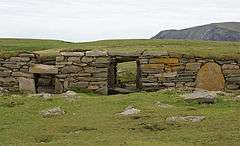 |
Sumburgh | Shetland | 100 BC | Blockhouse fort | Surviving to only 1.5 m in height, the blockhouse was once 22m long, but has suffered from cliff erosion.[54][55] |
| Midhowe Broch | 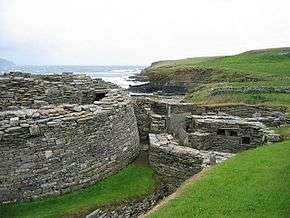 |
Rousay | Orkney | 1st century BC or older | Settlement | Lies opposite the Broch of Gurness overlooking Eynhallow Sound.[56] |
| Broch of Burrian | North Ronaldsay | Orkney | 1st century BC | Broch | May have had three distinct phases of occupation.[57][58] | |
| Dun Beag |  |
Bracadale, Skye | Highland | Late 1st millennium BC | Broch | Visited by Boswell and Johnson in the 18th century.[59][60] |
| Mine Howe |  |
Tankerness | Orkney | 100BC - 110AD | Souterrain | Once thought to be a broch, it was used for metal working and may have had a religious purpose.[61] |
| Broch of Gurness |  |
Evie | Orkney | 60 AD or older | Settlement | Oldest confirmed dates are Roman pottery from 60 AD and radiocarbon dates for the late first century.[62][63] |
| Dun Mor Vaul |  |
Tiree | Argyll and Bute | 60 AD | Dun | The original structure dates to c. 445 BC. A fragment of a Roman glass bowl made in the Rhineland between AD 160 and 250 was discovered in the interior.[64][Note 2] |
| Broch of West Burrafirth |  |
East of Sandness | Shetland | 100 AD or older | Broch | The stone stands eight or nine courses high for much of the circumference.[65][66] |
| Dun Fiadhairt |  |
Duirinish, Skye | Highland | 200 AD or older | Broch | A clay model of a bale of wool, believed to be Roman, may reflect trade between the two cultures although a Roman fleet is known to have circumnavigated Scotland in the 1st century AD.[67][68] |
| Edin's Hall Broch |  |
Abbey St Bathans | Berwickshire | 100-140AD | Broch | Broch believed to have been constructed between the two Roman occupations of southern Scotland, on the site of a much earlier fort.[69] |
| Broch of Borwick |  |
Yesnaby | Orkney | 200 AD? | Broch | On a cliff promontory, the seaward wall is badly eroded.[70][71] |
| Tappoch Broch |  |
Torwood | Falkirk | 3rd century AD? | Broch | Dating evidence is sparse, with no finds to link the broch to Roman occupation of nearby Antonine Wall resulting in the suggestion the broch either pre- or post- dates Roman occupation.[72][73] |
| Dun Cuier |  |
Barra | Na h-Eileanan Siar | 4th century AD | Galleried dun | A complex and controversial site, with two periods of occupation in the 4th and 7th centuries.[74] |
Early Historic period
| Building | Image | Location | Council area | First built | Use | Notes |
|---|---|---|---|---|---|---|
| St Columba's Monastery |  |
Eileach an Naoimh | Argyll and Bute | 6th century? | Monastic cells | The monastic site was founded in 542. The oldest remains include a double beehive cell and a grave associated with the mother of Columba. These are the oldest extant church buildings in Scotland and possibly Britain.[75][76][77][78] |
| Dun Carloway |  |
Carloway | Na h-Eileanan Siar | 650 and earlier | Broch | Radiocarbon date is for a late period of occupation likely to be centuries after the building was completed.[79] |
| Brough of Birsay |  |
Birsay | Orkney | 800 | Settlement | Pictish remains date from the 5th century and the Norse period provides building work from 800-1200.[80][81] |
| St Oran's Chapel |  |
Iona | Argyll and Bute | 9th or 10th century | Chapel | Partly rebuilt and restored.[82] Possibly built by Somerled c. 1164.[83] |
| Brechin Cathedral Round Tower |  |
Brechin | Angus | 1012 | Round Tower | The tower probably predates the cathedral itself.[84][85] |
| Abernethy Round Tower |  |
Abernethy | Perth and Kinross | 1100 | Round Tower | The tower is 22 metres (72 ft) high.[1][86] |
12th century
| Building | Image | Location | Council area | First built | Use | Notes |
|---|---|---|---|---|---|---|
| St Rule's Tower |  |
St Andrews | Fife | 1123 | Priory | Constructed by the Culdees prior to the granting of the church to the Augustinian order.[87] |
| Inchcolm Abbey | 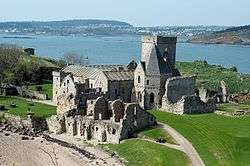 |
Inchcolm | Fife | Founded 1123 | Abbey | The substantial ruins date "from the 12th century" onwards.[88] |
| Holyrood Abbey |  |
Holyrood Palace | Edinburgh | c. 1130 | Abbey | Founded in 1128 by David I but all that remains above ground of the original structure is the ruined nave. The rest of the building was replaced by the mid 13th century.[89][90] |
| St Margaret's Chapel |  |
Edinburgh Castle | Edinburgh | 1130 | Chapel | The oldest building in Edinburgh.[91] |
| Cubbie Roo's Castle | 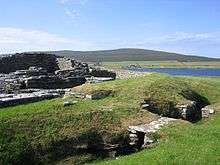 |
Wyre | Orkney | c. 1145 | Castle | The ruins include a small square keep still extant to 2.4 metres (8 ft) in height.[92] |
| Castle Sween | 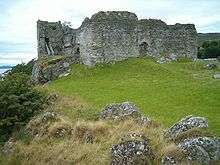 |
Knapdale | Argyll and Bute | c. 1150 | Castle | The main structure is a mid-12th-century quadrangle with later towers.[93] |
| St Serf's Inch Priory |  |
St Serf's Inch | Perth and Kinross | Post 1150 | Priory | The remaining oblong structure dates from 12th century.[94] |
| Jedburgh Abbey |  |
Jedburgh | Scottish Borders | Post 1150 | Abbey | The choir dates to the second quarter of the 12th century and the church was complete by the middle of the 13th century.[95] |
| St. Magnus Cathedral | 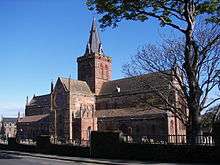 |
Kirkwall | Orkney | Commenced 1167 | Cathedral | The building was raised in honour of Magnus Erlendsson, Earl of Orkney by Earl Rögnvald Kali.[96] |
| Bishop's Palace, Kirkwall | 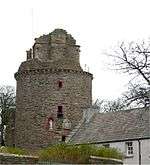 |
Kirkwall | Orkney | c. 1167 | Residence | Built for William the Old, Bishop of Orkney, Haakon IV of Norway died here in 1263.[97] |
| Kilwinning Abbey | Kilwinning | North Ayrshire | 1190 | Abbey | An arch has a Norman style capital bearing two carved figures.[98] | |
| St Magnus's Church |  |
Egilsay | Orkney | Late 12th century | Church | A church existed here in 1116, but the current building, with its distinctive round tower, may date from later that century.[99] |
| Kildalton Chapel | 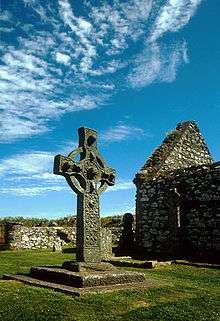 |
Islay | Argyll and Bute | Late 12th century | Church | The churchyard has a collection of grave slabs and contains the 8th-century Kildalton Cross.[100] |
| St Blane's Church, Kingarth | Kingarth | Argyll and Bute | 12th century | Church | A "12th-century Romanesque building consisting of a nave and chancel", the enclosing wall and parts of the church may be pre-Norse.[101] | |
13th century
Castles
| Building | Image | Location | Council Area | First Built | Use | Notes |
|---|---|---|---|---|---|---|
| Aberdour Castle | Aberdour | Fife | 1200 | Castle | Base of a late-12th- or early-13th-century hall house incorporated into later buildings.[102] | |
| Dirleton Castle | 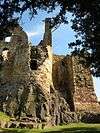 |
Dirleton | East Lothian | 1240 | Castle | The de Vaux towers are the oldest extant structures.[103][104] |
| Kildrummy Castle | Kildrummy | Aberdeenshire | c. 1250 | Castle | Built mid 13th century, possibly by Gilbert de Moravia and fell under siege in 1306 during the Wars of Independence.[105][106] | |
| Dunstaffnage Castle |  |
Oban | Argyll and Bute | pre 1275 | Castle | Built by Clan MacDougall on an older site.[107][108] |
| Duart Castle |  |
Craignure, Mull | Argyll and Bute | Late 13th century | Castle | Part of a chain of castles that line the Sound of Mull.[109][110] |
| Lauriston Castle | St Cyrus | Aberdeenshire | Late 13th century | Castle | The charter dates from c. 1243, and some of the 13th-century structure is incorporated in later building works. Captured by Edward III of England in 1336.[104][111] | |
| Goblin Ha' |  |
Gifford | East Lothian | 13th century | Undercroft | Part of Yester Castle built by Sir Hugo de Gifford, reputedly a "wizard".[112][113] |
Religious buildings
| Building | Image | Location | Council Area | First Built | Use | Notes |
|---|---|---|---|---|---|---|
| Iona Nunnery | 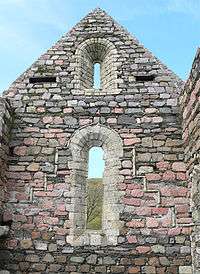 |
Iona | Argyll and Bute | Founded 1207 | Nunnery | "The remains, substantial and, at least in part, original were repaired in 1923".[114] |
| Iona Abbey |  |
Iona | Argyll and Bute | 1200-1220 | Monastery | The north transept "is the only part of this early church to survive reasonably intact".[115] |
| Pluscarden Abbey |  |
Elgin | Moray | Founded 1230 | Monastery | Originally Valliscaulian, now a Benedictine House.[116] |
| Ardchattan Priory | 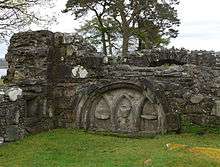 |
Ardchattan | Argyll and Bute | Founded 1230 | Monastery | Also Valliscaulian, and dedicated to St May and St John the Baptist. Now ruined.[117] |
| Fortrose Cathedral | Fortrose | Highland | 1235 | Undercroft | The undercroft of the chapter house is only structure remaining from this date.[118] | |
| Inchmahome Priory | 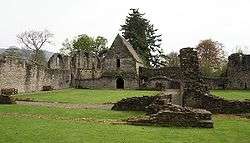 |
Inchmahome | Stirling | Founded 1238 | Priory | "Much of the 13th-century building remains."[119] |
| Nave Island Chapel |  |
Islay | Argyll and Bute | Pre 1250 | Church | The site is within an enclosure that is likely to be several centuries older, The chimney is an 18th-century addition made by kelp harvesters.[120] |
| Kelso Abbey | 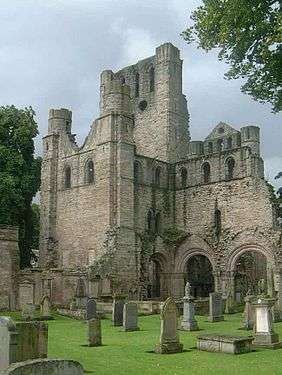 |
Kelso | Scottish Borders | Completed 1248 | Abbey | Suffered significant damage during "The Rough Wooing".[121] |
| Arbroath Abbey | 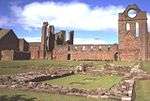 |
Arbroath | Angus | Completed mid-13th century | Abbey | The tower dates from the 13th century.[122] |
| Crossraguel Abbey | 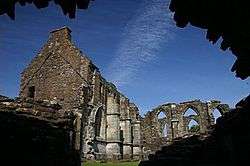 |
Maybole | South Ayrshire | Completed c. 1265 | Abbey | [123] |
| Beauly Priory |  |
Beauly | Highland | Completed 1272 | Monastery | Described by the monks as Prioratus de Bello Loco in 1230.[124] |
| Sweetheart Abbey | 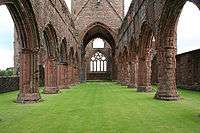 |
New Abbey | Dumfries and Galloway | Founded 1273 | Abbey | A Cistercian monastery founded in 1275 by Dervorguilla of Galloway.[125] |
| Dunstaffnage Chapel |  |
Oban | Argyll and Bute | pre 1275 | Chapel | Adjacent to Dunstaffnage Castle.[107][108] |
| Balmerino Abbey |  |
Balmerino | Fife | Completed c. 1286 | Abbey | Founded in 1231, badly damaged in the 16th century.[126] |
| Culross Abbey |  |
Culross | Fife | Late 13th century | Abbey | Founded before 1217, parts of the nave are early-13th-century, but most of the original structures are c. 1300.[127] |
By council area
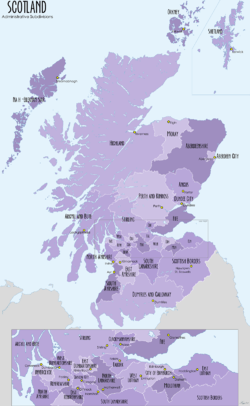
The following are amongst the oldest buildings in each council area of Scotland.
| Building | Image | Council area | Location | First Built | Use | Notes |
|---|---|---|---|---|---|---|
| St Machar's Cathedral |  |
Old Aberdeen | Aberdeen City | 1440 | Church | The nave and its two western towers were built between 1422 and 1440.[128][Note 3] |
| Kildrummy Castle | Kildrummy | Aberdeenshire | c. 1250 | Castle | Built mid 13th century, possibly by Gilbert de Moravia and fell under siege in 1306 during the Wars of Independence.[105][106] | |
| Brechin Cathedral Round Tower |  |
Brechin | Angus | 1012 | Round Tower | The tower probably predates the cathedral itself.[84][85] |
| Glebe cairn |  |
Kilmartin Glen | Argyll and Bute | 1700 BC | Tomb | An early Bronze Age structure with two stone cists.[38][39] |
| Clackmannan Tower | 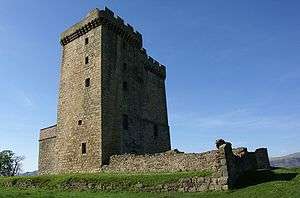 |
Clackmannan | Clackmannanshire | Late 14th century | Tower house | L-plan tower house extended in the 15th century.[131][Note 4] |
| Sweetheart Abbey |  |
New Abbey | Dumfries and Galloway | Founded 1273 | Abbey | A Cistercian monastery founded in 1275 by Dervorguilla of Galloway.[125] |
| St Mary's Tower |  |
Nethergate | Dundee City | 1495 | Church | Also known as "The Old Steeple"[135] and described as "the oldest surviving building in Dundee".[136] |
| Mauchline Castle |  |
Mauchline | East Ayrshire | 1450 | Former grange | Built by Andrew Hunter, abbot of Melrose Abbey.[137][138] |
| Bardowie Castle | 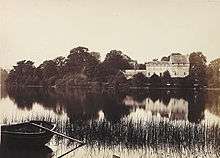 |
Milngavie | East Dunbartonshire | 1566 | Castle | 16th-century tower with later additions.[139] |
| Dirleton Castle |  |
Dirleton | East Lothian | 1240 | Castle | The de Vaux towers are the oldest extant structures.[103][104] |
| Mearns Castle |  |
Newton Mearns | East Renfrewshire | Post 1449 | Tower house | Restored and now used by a local church.[140] |
| St Margaret's Chapel |  |
Edinburgh Castle | City of Edinburgh | 1130 | Chapel | The oldest building in Edinburgh.[91] |
| Tappoch Broch |  |
Torwood | Falkirk | 3rd century | Broch | Likely post dates Roman occupation of nearby Antonine Wall.[72][73] |
| St Rule's Tower |  |
St Andrews | Fife | 1123 | Priory | Constructed by the Culdees prior to the granting of the church to the Augustinian order.[87] |
| Provan Hall | 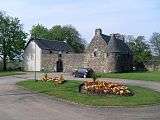 |
Easterhouse | Glasgow City | 1460 | Mansion house | Possibly the best-preserved medieval fortified country house in Scotland.[141][142] |
| Grey Cairns of Camster |  |
Upper Camster | Highland | 3000 BC or older | Tomb | A group of three cairns.[16][17] |
| Newark Castle |  |
Port Glasgow | Inverclyde | 1478 | Castle | The original castle had a tower house within a barmkin entered through a large gatehouse.[143] |
| Crichton Castle |  |
Crichton | Midlothian | Late 14th century | Tower house | The tower is the oldest section, with later additions.[144][145] |
| Pluscarden Abbey |  |
Elgin | Moray | Founded 1230 | Monastery | Originally Valliscaulian, now a Benedictine House.[116] |
| Barpa Langass |  |
North Uist | Na h-Eileanan Siar | 3000 BC | Tomb | The best preserved chambered cairn in the Hebrides.[21][22] |
| Kilwinning Abbey | Kilwinning | North Ayrshire | 1190 | Abbey | An arch has a Norman style capital bearing two carved figures.[98] | |
| Dalzell House | Motherwell | North Lanarkshire | Early 16th century | Tower house | Substantial later additions.[146] | |
| Knap of Howar |  |
Papa Westray | Orkney | 3700 BC | House | Oldest preserved stone house in north west Europe.[3][4][5] |
| Abernethy Round Tower |  |
Abernethy | Perth and Kinross | Late 11th century | Tower | The tower is 22 metres (72 ft) high.[1][86] |
| Paisley Abbey |  |
Paisley | Renfrewshire | Mid 15th century | Abbey | The main structure is a restoration of an earlier building destroyed in 1307, although a late-12th-century and a 13th-century doorway remain.[147] |
| Jedburgh Abbey |  |
Jedburgh | Scottish Borders | Post 1150 | Abbey | The choir dates to the second quarter of the 12th century and the church was complete by the middle of the 13th century.[95] |
| Old Scatness |  |
Sumburgh | Shetland | 400-200 BC | Broch and wheelhouse | Like Jarlshof the site was occupied by Iron Age peoples, Picts, and Vikings.[42] |
| Crossraguel Abbey |  |
Maybole | South Ayrshire | c. 1265 | Abbey | [123] |
| St Brides Collegiate Church |  |
Bothwell | South Lanarkshire | Founded 1398 | Church | The oldest visible structure is the choir, which dates from the 14th century.[148] |
| Inchmahome Priory |  |
Inchmahome | Stirling | Founded 1238 | Priory | "Much of the 13th-century building remains."[119] |
| Glencairn House |  |
Dumbarton | West Dunbartonshire | 1623 | Tenement | Built for the Earl of Glencairn, now owned by the Council and described as "oldest building in West Dunbartonshire".[149][150] |
| Torphichen Preceptory | 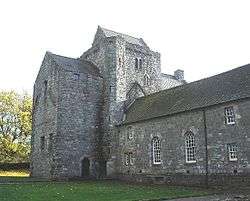 |
Torphichen | West Lothian | 13th century | Church | The only house of the Knights Hospitallers of St John of Jerusalem in Scotland.[151][152][Note 5] |
Other structures
Undated buildings
The following are very old buildings that meet the qualifying criteria but for which no reliable date of construction has emerged.
| Building | Image | Location | Council Area | First Built | Use | Notes |
|---|---|---|---|---|---|---|
| Calf of Eday cairns |  |
Calf of Eday | Orkney | Neolithic and built in two phases. | Tomb | There are two preserved chambered tombs close together on this Orkney islet and a third in a ruinous state. |
| Huntersquoy cairn | 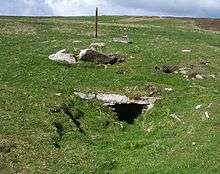 |
Eday | Orkney | Neolithic | Tomb | A Bookan type cairn with an upper and lower storey.[154] |
| Broch of Culswick |  |
Sandsting | Shetland | Iron Age | Broch | Until the 18th century this was Shetland's second most complete broch, after Mousa.[155][156] |
| Burra Ness Broch |  |
Yell | Shetland | Iron Age | Broch | The wall still stands 14' high in places.[157] |
| Burroughston Broch | 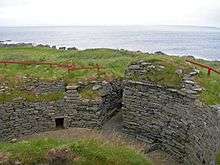 |
Shapinsay | Orkney | Iron Age | Settlement | Likely to "have been seen by seafaring Romans about two millennia ago."[158] |
| Carn Liath |  |
Golspie | Highland | Iron Age | Broch | [159] |
| Clachtoll broch |  |
Stoer | Highland | Iron Age | Broch | [160] |
| Dun Dornaigil | South of Ben Hope | Highland | Iron Age | Broch | [161] | |
| Dun Hallin |  |
Waternish, Skye | Highland | Iron Age | Broch | [162] |
| Dun Grugaig |  |
Glenelg | Highland | Iron Age | Semi-broch | [163][164] |
| Kintradwell broch |  |
Brora | Highland | Iron Age | Broch | [165] |
| Sallachy broch |  |
Lairg | Highland | Iron Age | Broch | [166] |
| Stairhaven | 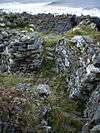 |
Luce Bay | Dumfries and Galloway | Probable Iron Age | Possible broch | Also known as Crow's Neith and Broken Castle.[167] |
| Tirefour Castle |  |
Lismore | Argyll and Bute | Iron Age | Broch | The walls have an average thickness of 4.5 metres (15 ft) enclosing a court about 12.2 metres (40 ft) in diameter. The wall still stands 3 metres (9.8 ft) high.[168] |
| Burghead Well |  |
Burghead | Moray | Dark Age? | Baptistery? | This underground structure is unique in a Scottish context and is probably of Dark Age origin, although it may be older.[169] |
| Restenneth Priory | 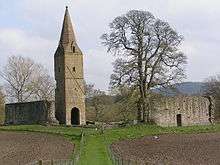 |
Forfar | Angus | 13th century? | Monastery | Probably built on a much earlier site and the date of the extant structures is not clear.[170][171] |
Other prehistoric constructions
The following are very old human constructions that do not fit the above criteria for a building.
| Building | Image | Location | Council area | First built | Use | Notes |
|---|---|---|---|---|---|---|
| Funzie Girt |  |
Fetlar | Shetland | Possibly Neolithic | Wall | The wall ran for over 4 kilometres (2.5 mi) and once divided the island in two. "Its date and precise purpose are unknown, but a considerable degree of antiquity is suggested."[172] |
| Dwarfie Stane |  |
Hoy | Orkney | 3rd millennium BC | Tomb | A megalithic chambered tomb carved out of a titanic block of Devonian Old Red Sandstone.[173][174] |
See also
- Architecture of Scotland in the Prehistoric era
- Timeline of prehistoric Scotland
- Oldest buildings in the United Kingdom
- List of the oldest buildings in the world
- Newgrange, one of Ireland's oldest buildings dating from c. 3100 BC
- La Hougue Bie, one of Jersey's oldest buildings dating from c. 3500 BC
Notes
- ↑ The excavator, Euan MacKie, identified two successive visits to the site by a Roman fleet during Governor Agricola's campaigns in the AD 80s. The first resulted in presents for the chief but the second in the burning and destruction of the site. The fort guards the entrance of Loch Harport which may be the Roman harbour Portus Trucculensis mentioned by Tacitus.
- ↑ This broch was excavated in 1962-64 by Euan MacKie. It was the first to be radiocarbon-dated, the first to revealed deposits dating from its construction and the first to reveal evidence for deliberate demolition. New C14 dates may shortly be available.
- ↑ Brig o' Balgownie was originally constructed in the 14th century by Richard Cementarius but was "largely rebuilt" in the early 17th century.[129] Provost Skene's House in Broad Street dates from 1545 and is probably the oldest house in the city.[130]
- ↑ Tullibody Old Bridge, which dates from the early 16th century[132][133] has been described as "the oldest structure in Clackmannanshire" by Clackmannanshire Council.[134]
- ↑ According to RCAHMS, Abercorn church dates "from the later 11th century and has been much altered" and "the only feature certainly of that date is the blocked S door".[153]
Footnotes
- 1 2 3 "Abernethy Round Tower". Historic Scotland. Retrieved 13 August 2012.
- ↑ Armit (2003) p. 16
- 1 2 "Knap of Howar" Historic Scotland. Retrieved 23 Sept 2011.
- 1 2 "The Knap o' Howar, Papay". Orkneyjar. Retrieved 13 July 2012.
- 1 2 Wickham-Jones (2007) p. 40.
- ↑ "The Midhowe Stalled Cairn, Rousay". Orkneyjar. Retrieved 13 July 2012.
- 1 2 3 Fraser, David (1980) Investigations in Neolithic Orkney. Glasgow Archaeological Journal. 7 p. 13. ISSN 1471-5767
- ↑ "Unstan Chambered Cairn". Historic Scotland. Retrieved 21 July 2012.
- ↑ Wickham-Jones (2007) p. 48
- ↑ "Rousay, Knowe of Yarso". Canmore. Retrieved 20 July 2012.
- ↑ Wickham-Jones (2007) pp. 56-57
- ↑ Wickham-Jones (2007) p. 50
- ↑ Clarke, David (2000) Skara Brae; World Heritage Site. Historic Scotland. ISBN 1900168979
- ↑ "Tomb of the Eagles" tomboftheeagles.co.uk. Retrieved 11 February 2008.
- ↑ Hedges, J. 1990. Tomb of the Eagles: Death and Life in a Stone Age Tribe. New Amsterdam Books. ISBN 0-941533-05-0 p. 73
- 1 2 "Grey Cairns of Camster". Megalithic Portal. Retrieved 21 July 2012.
- 1 2 "Grey Cairns of Camster". Historic Scotland. Retrieved 21 July 2012.
- ↑ "The Taversoe Tuick, Rousay" Orkneyjar. Retrieved 17 July 2012.
- ↑ "Info Board, Holm of Papa Westray Cairn" Wikimedia Commons/Historic Scotland. Retrieved 17 July 2012.
- ↑ Wickham-Jones (2007) pp. 62-63
- 1 2 "North Uist, Barpa Langass". Canmore. Retrieved 18 July 2012.
- 1 2 Armit (1996) p. 71
- ↑ "The Cuween Hill Cairn, Firth". Orkneyjar. Retrieved 21 July 2012.
- ↑ "Cuween Hill Chambered Cairn". Historic Scotland. Retrieved 21 July 2012.
- ↑ "The Quoyness Cairn, Sanday". Orkneyjar. Retrieved 19 July 2012.
- ↑ Childe, V. Gordon; W. Douglas Simpson (1952). Illustrated History of Ancient Monuments: Vol. VI Scotland. Edinburgh: Her Majesty's Stationery Office. pp.18-19
- ↑ Ritchie, Graham & Anna (1981). Scotland: Archaeology and Early History. New York: Thames and Hudson. ISBN 0-500-27365-0. p. 29
- ↑ "C14 Radiocarbon dating for Crantit" Canmore. Retrieved 20 July 2012.
- ↑ "Crantit" Canmore. Retrieved 20 July 2012.
- ↑ Armit (1996) p. 73
- ↑ "Skye, Rubh' An Dunain, 'Viking Canal' ". Canmore. Retrieved 7 May 2011.
- 1 2 "The Cairns of Clava, Scottish Highlands". The Heritage Trail. Retrieved 19 July 2012.
- ↑ "Corrimony Chambered Cairn & RSPB Nature Reserve". Glen Affric.org. Retrieved 21 July 2012.
- ↑ "Corrimony Chambered Cairn". Historic Scotland. Retrieved 21 July 2012.
- ↑ "A Visitors’ Guide to Balnuaran of Clava: A prehistoric cemetery. (2012) Historic Scotland.
- ↑ Bradley, Richard (1996) Excavation at Balnuaran of Clava, 1994 and 1995. Highland Council.
- ↑ Uney, Graham (2010) Walking on the Orkney and Shetland Isles: 80 Walks in the Northern Isles. Cicerone Press. p. 71
- 1 2 "Glebe cairn". Saints and Stones. Retrieved 4 August 2012.
- 1 2 "Kilmartin Glebe". Canmore. Retrieved 4 August 2012.
- ↑ "Skye, Dun Ringill". Canmore. Retrieved 4 August 2012.
- ↑ Miers (2008) p. 215
- 1 2 "Old Scatness Broch". Undiscovered Scotland. Retrieved 29 July 2012.
- 1 2 "Dun Troddan". Canmore. Retrieved 27 July 2012.
- 1 2 Miers (2008) p. 172
- ↑ "Jarlshof Prehistoric & Norse Settlement" Historic Scotland. Retrieved 2 August 2008.
- ↑ Armit, Ian (1991) The Atlantic Scottish Iron Age: five levels of chronology. Proc Soc Antiq Scot 121 page 193
- ↑ "Yarrows". Canmore. Retrieved 11 August 2011.
- ↑ "Yarrows Archaeological Trail". (2012) Highland Council.
- ↑ "South Uist, Bornish, Dun Vulan". Canmore. Retrieved 12 August 2011.
- ↑ Miers (2008) pp. 145-56
- ↑ "Skye, Dun Ardtreck". Canmore. Retrieved 2 August 2008.
- ↑ Fojut, Noel (1981)"Is Mousa a broch?" Proc. Soc. Antiq. Scot. 111 pp. 220-228.
- ↑ Armit (2003) p. 15
- ↑ "Ness of Burgi". Canmore. Retrieved 12 August 2012.
- ↑ "Ness of Burgi". Stone Pages. Retrieved 12 August 2012.
- ↑ Armit (2003) p. 107
- ↑ "North Ronaldsay, Broch of Burrian". Canmore. Retrieved 6 August 2012.
- ↑ "The Broch of Burrian, North Ronaldsay, Orkney". BIAB. Retrieved 6 August 2012.
- ↑ "Skye, Dun Beag, Struanmore". Canmore. Retrieved 4 August 2012.7
- ↑ Miers (2008) p. 240
- ↑ "Mine Howe". Canmore. Retrieved 2 August 2012.7
- ↑ Armit (2003) p. 108
- ↑ Moffat, Alistair (2005) Before Scotland: The Story of Scotland Before History. London. Thames & Hudson. pp. 173-4.
- ↑ "Tiree, Dun Mor, Vaul". Canmore. Retrieved 4 August 2012.
- ↑ "West Burra Firth". Canmore. Retrieved 29 July 2012.
- ↑ MacKie, E W (1965) "The origin and development of the broch and wheelhouse building cultures of the Scottish Iron Age". Proc Prehist Soc. 31.
- ↑ "Skye, Duirinish, Dun Fiadhairt". Canmore. Retrieved 12 August 2012.
- ↑ Armit (2003) p. 117
- ↑ Canmore. Retrieved 29 August 2012
- ↑ "The Broch o' Borwick, Sandwick". Orkneyjar. Retrieved 6 August 2012
- ↑ "The Broch o' Borwick, Sandwick". Canmore. Retrieved 6 August 2012
- 1 2 ."Torwood, Tappoch Broch". Canmore. Retrieved 6 August 2012
- 1 2 "Torwood or Tappoch Broch". Falkirk Local History Society. Retrieved 6 August 2012
- ↑ "Barra, Dun Cuier". Canmore. Retrieved 12 August 2012
- ↑ Pallister, Marian (2005) Lost Argyll: Argyll's Lost Heritage. Edinburgh. Birlinn. Pages 120 and 133.
- ↑ "Garvellachs, Eileach An Naoimh" Canmore. Retrieved 13 Feb 2011.
- ↑ "Jura National Scenic Area" (2010) (pdf) Extract from: The special qualities of the National Scenic Areas. SNH Commissioned Report No.374. Scottish Natural Heritage. Retrieved 13 Feb 2011.
- ↑ "St. Columba's Monastery". Historic Scotland Retrieved 13 August 2012
- ↑ Armit (1996) p. 246
- ↑ Batey, Colleen "Vikings and Late Norse Orkney" in Omand (2003) pp. 53-54
- ↑ "The Brough o' Birsay". Orkneyjar. Retrieved 29 July 2012.
- ↑ "Iona, St Oran's Chapel And Reilig Odhrain Burial Ground". Canmore. Retrieved 29 July 2012.
- ↑ "The Western church and Irish influence: Iona, Dunstaffnage and Skipness". Department of History of Art, University of Glasgow. Retrieved 4 August 2012.
- 1 2 "Brechin Cathedral". Canmore. Retrieved 14 August 2012.
- 1 2 "Round Tower At South West Angle Of Cathedral Church Lane: Listed Building Report". Historic Scotland.
- 1 2 "Abernethy Round Tower". Canmore. Retrieved 30 July 2012.
- 1 2 "St Rule's Tower". Undiscovered Scotland. Retrieved 27 July 2012.
- ↑ "Incholm Abbey". Canmore. Retrieved 30 July 2012.
- ↑ "Holyrood Abbey and Palace gardens". Historic Scotland. Retrieved 27 Jul 7 2012. Check date values in:
|access-date=(help) - ↑ "Edinburgh, Holyrood Abbey". Canmore. Retrieved 27 July 2012.
- 1 2 "About St. Margaret's Chapel". Historic Scotland. Retrieved 26 July 2012.
- ↑ "Cubbie Roo's Castle". Canmore. Retrieved 31 Dec 2011.
- ↑ "Castle Sween". Canmore. Retrieved 29 July 2012.
- ↑ "Loch Leven, St Serf's Island, St Serf's Priory Church". Canmore. Retrieved 30 July 2012.
- 1 2 "Jedburgh Abbey". Canmore. Retrieved 31 July 2012.
- ↑ Crawford, Barbara E. "Orkney in the Middle Ages" in Omand (2003) pp. 69-70
- ↑ "The Bishop's Palace, Kirkwall". Orkneyjar. Retrieved 29 July 2012.
- 1 2 McAleer, J. Philip (1995). Towards an architectural history of Kilwinning Abbey. Proc Soc Antiq Scot. 125 pp. 841-853.
- ↑ "Egilsay, St Magnus's Church". Canmore. Retrieved 29 July 2012.
- ↑ "Kildalton Cross". Undiscovered Scotland. Retrieved 15 August 2012.
- ↑ "Bute, St Blane's Church". Canmore. Retrieved 4 August 2012.
- ↑ Tabraham, Chris, Scotland's Castles (BT Batsford/Historic Scotland, 1997, ISBN 0-7134-7965-5), p. 33
- 1 2 Coventry (2008) p. 582
- 1 2 3 "Dirleton Castle". Historic Scotland. Retrieved 29 July 2012.
- 1 2 Coventry (2008) p. 449
- 1 2 "Kildrummy Castle". Historic Scotland. Retrieved 29 July 2012.
- 1 2 Coventry (2008) p. 365
- 1 2 "Dunstaffnage Castle and Chapel". Historic Scotland. Retrieved 29 July 2012.
- ↑ Coventry (2008) p. 386
- ↑ "Duart Castle". Canmore. Retrieved 29 July 2012.
- ↑ Coventry (2008) p. 562
- ↑ Coventry (2008) p. 220
- ↑ "Yester Castle and Goblin Ha'". Canmore. Retrieved 29 July 2012.
- ↑ "Iona, Iona Nunnery". Canmore. Retrieved 31 July 2012.
- ↑ McDonald (2007) p. 245
- 1 2 "Pluscarden Abbey". Canmore. Retrieved 30 July 2012.
- ↑ "Ardchattan Priory". Canmore. Retrieved 30 July 2012.
- ↑ "Fortrose Cathedral". Canmore. Retrieved 20 August 2012.
- 1 2 "Inchmahome Priory". Historic Scotland. Retrieved 31 July 2012.
- ↑ "Islay, Nave Island". Canmore. Retrieved 15 August 2012.
- ↑ "Kelso, Bridge Street, Abbey". Canmore. Retrieved 30 July 2012.
- ↑ "Arbroath Abbey, Regality Tower". Canmore. Retrieved 30 July 2012.
- 1 2 "Crossraguel Abbey". Canmore. Retrieved 30 July 2012.
- ↑ "Beauly Priory". Undiscovered Scotland. Retrieved 30 July 2012.
- 1 2 "Sweetheart Abbey". Canmore. Retrieved 30 July 2012.
- ↑ "Balmerino Abbey". Undiscovered Scotland. Retrieved 30 July 2012.
- ↑ "Culross Abbey". Canmore. Retrieved 30 July 2012.
- ↑ "Aberdeen, The Chanonry, St Machar's Cathedral and Churchyard". Canmore. Retrieved 13 August 2012.
- ↑ "Brig O' Balgownie Over River Don, Listed Building Report". Historic Scotland. Retrieved 13 August 2012.
- ↑ "Provost Skene's House". Aberdeen Art Gallery & Museums. Aberdeen City Council. Retrieved 13 August 2012.
- ↑ "Clackmannan Tower, Listed Building Report". Historic Scotland. Retrieved 2010-05-10.
- ↑ "Tullibody Old Bridge". Clackmannanshire Council. Retrieved 13 August 2012.
- ↑ "Tullibody Old Bridge over River Devon, Bridgend". (9 June 1960) Historic Scotland. Retrieved 4 August 2012.
- ↑ "Clackmannanshire View". (Winter 2010) Issue 5. Clackmannanshire Council.
- ↑ "Nethergate, City Churches, St Clement's, or Steeple Church, Category A Listing". Historic Scotland. 12 July 1963. Retrieved 27 March 2012.
- ↑ "Dundee Parish Church (St. Mary's)". Dundee Parish Church. Retrieved 13 August 2012.
- ↑ "Mauchline Castle (Abbot Hunter's Tower): Listed Building Report". Historic Scotland. Retrieved 2010-06-05.
- ↑ "Mauchline Castle". Canmore. Retrieved 14 August 2012.
- ↑ "Bardowie Castle". Canmore. Retrieved 13 August 2012.
- ↑ "Church Of Maxwell, Mearns Castle, Broom Road, By Newton Mearns, Listed Building Report". Historic Scotland. Retrieved 20 May 2010.
- ↑ "Provan Hall Heritage Trail". (pdf) Glasgow City Council. Retrieved 13 August 2012.
- ↑ "Provan Hall" Undiscovered Scotland. Retrieved 13 August 2012.
- ↑ "Newark Castle". Undiscovered Scotland. Retrieved 14 August 2012.
- ↑ "Chrichton Castle". Canmore. Retrieved 14 August 2012.
- ↑ "Chrichton Castle". Listed Building Report. Historic Scotland. Retrieved 14 August 2012.
- ↑ "Dalzell House, Listed Building Report". Historic Scotland. Retrieved 2010-05-13.
- ↑ "Pailsey Abbey". Canmore. Retrieved 13 August 2012.
- ↑ "Bothwell, Main Street, St Bride's Collegiate Church". Canmore. Retrieved 13 August 2012.
- ↑ "Provost: 'Glencairn House can be a tourist attraction'". (30 Jan 2009) Lennox Herald. Retrieved 13 August 2012.
- ↑ "Dumbarton, 81 High Street, Glencairn Tenement". Canmore. Retrieved 13 August 2012.
- ↑ "Torphicen Preceptory". Undiscovered Scotland. Retrieved 13 August 2012.
- ↑ "Torphicen, Bowyett, Torphicen Preceptory and Torphicen Parish Church". Canmore. Retrieved 13 August 2012.
- ↑ "Abercorn Church and Anglian Monastery". Canmore. Retrieved 30 July 2012.
- ↑ Haswell-Smith, Hamish (2004). The Scottish Islands. Edinburgh: Canongate. p. 388. ISBN 978-1-84195-454-7.
- ↑ "Broch of Culswick". Canmore. Retrieved 12 August 2012.
- ↑ Lamb, R.G. (1975) "The Burri Stacks of Culswick, Shetland, and other paired stack-settlements". PSAS.
- ↑ "Yell, Burra Ness". Canmore. Retrieved 11 August 2012.
- ↑ C. Michael Hogan (2007) "Burroughston Broch". The Megalithic Portal. Retrieved 28 July 2012.
- ↑ "Carn Liath". Canmore. Retrieved 29 July 2012.
- ↑ "Clachtoll". Canmore. Retrieved 12 August 2012.
- ↑ "Dun Dornaigil". Canmore. Retrieved 28 July 2012.
- ↑ "Skye, Hallin". Canmore. Retrieved 12 August 2012.
- ↑ "Dune Grugaig, Glenelg". Canmore. Retrieved 12 August 2012.
- ↑ Miers (2008) p. 173
- ↑ "Kintradwell". Canmore. Retrieved 12 August 2012.
- ↑ "Sallachadh". Canmore. Retrieved 12 August 2012.
- ↑ "Stair Haven". Canmore. Retrieved 12 August 2012.
- ↑ "Lismore, Tirefour Castle". Canmore. Retrieved 12 August 2012.
- ↑ Burghead Well (1968) Ancient Monuments of Scotland. Crown copyright leaflet.
- ↑ "Restenneth Priory". Angus Council. Retrieved 15 December 2012.
- ↑ "Restenneth Priory". Canmore. Retrieved 15 December 2012.
- ↑ "Fetlar, Funziegirt". Canmore. Retrieved 15 May 2011.
- ↑ "The Dwarfie Stane, Hoy" Orkneyjar. Retrieved 27 May 2010.
- ↑ Wickham-Jones (2007) p. 54
References
- Armit, Ian (1996) The archaeology of Skye and the Western Isles. Edinburgh University Press/Historic Scotland.
- Armit, I. (2003) Towers in the North: The Brochs of Scotland. Stroud. Tempus. ISBN 0-7524-1932-3
- Coventry, Martin (2008) Castles of the Clans. Musselburgh. Goblinshead. ISBN 9781899874361
- McDonald, R. Andrew (2007) The Kingdom of the Isles: Scotland's Western Seaboard c. 1100 – c. 1336. East Linton. Tuckwell Press. ISBN 1-898410-85-2
- Miers, Mary (2008) The Western Seaboard: An Illustrated Architectural Guide. Rutland Press. ISBN 9781873190296
- Omand, Donald (ed.) (2003) The Orkney Book. Edinburgh. Birlinn. ISBN 1-84158-254-9
- Wickham-Jones, Caroline (2007) Orkney: A Historical Guide. Edinburgh. Birlinn. ISBN 1841585963